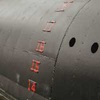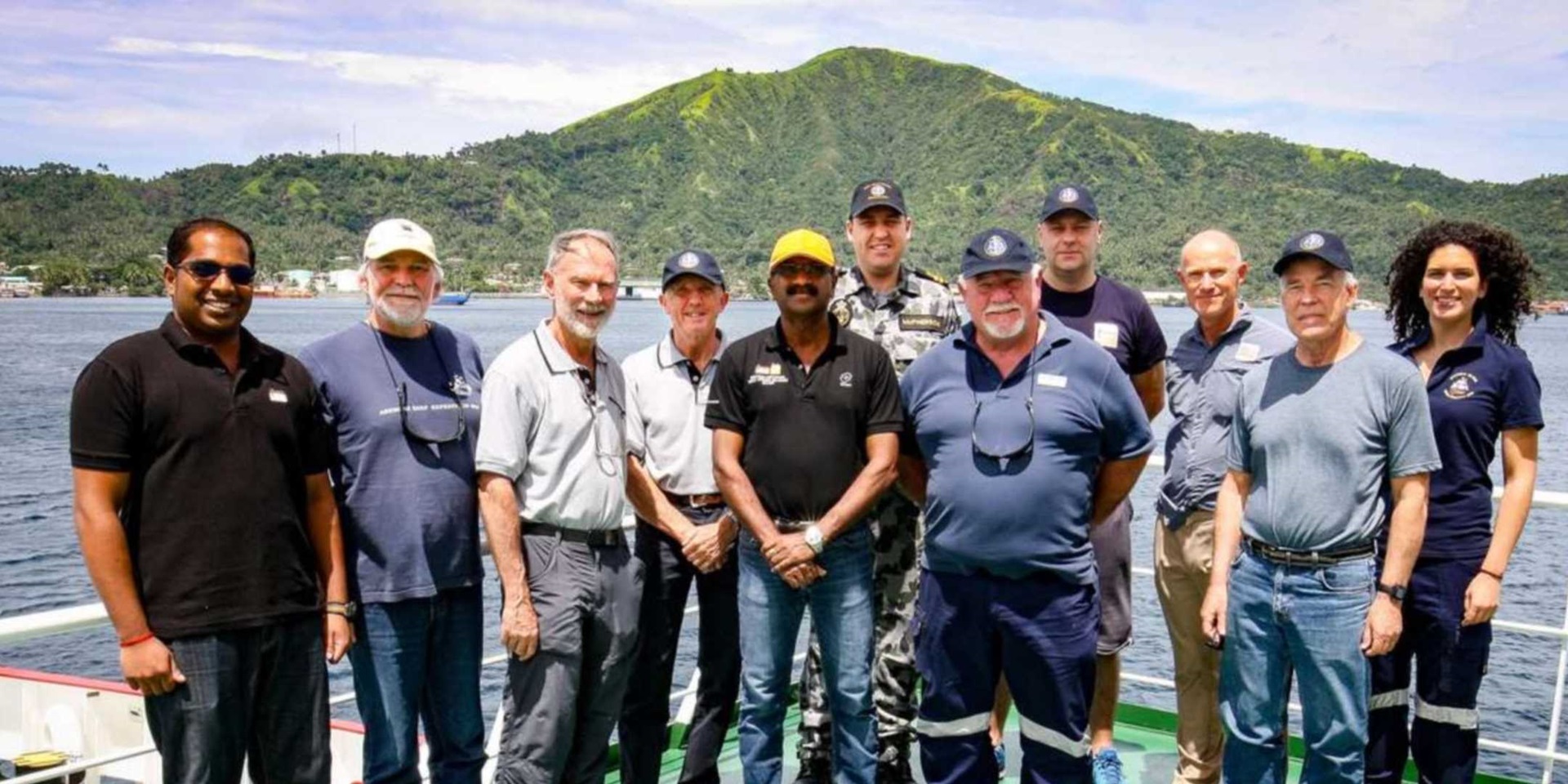
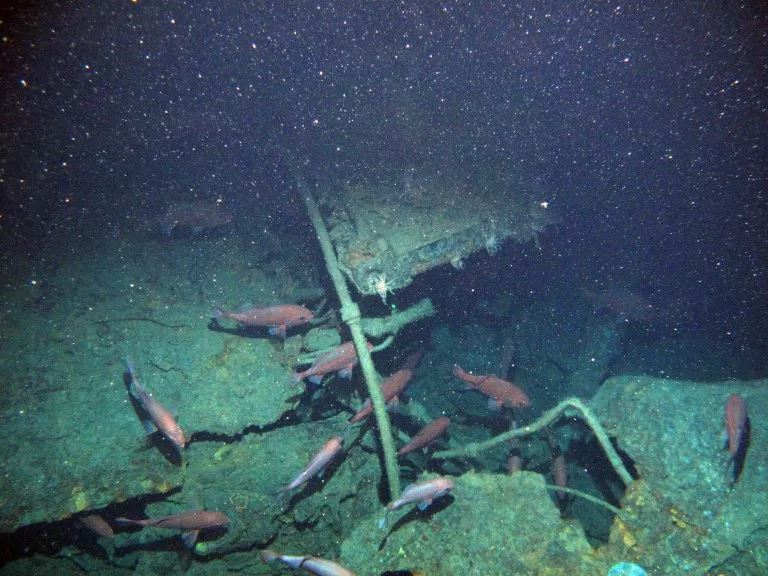
Part of AE1‘s hull, showing extensive corrosion. After 103 years since her loss, AE1 was located in waters off the Duke of York Island group in Papua New Guinea in December 2017. Image: Find the Men of AE1 Ltd.
Australia’s greatest naval mystery is solved at last
It is more than a century since Australia’s first submarine, HMAS AE1, disappeared without trace in the waters off Papua New Guinea. Its fate remained a mystery until late last year, when the most recent of many searches finally found its wreck.
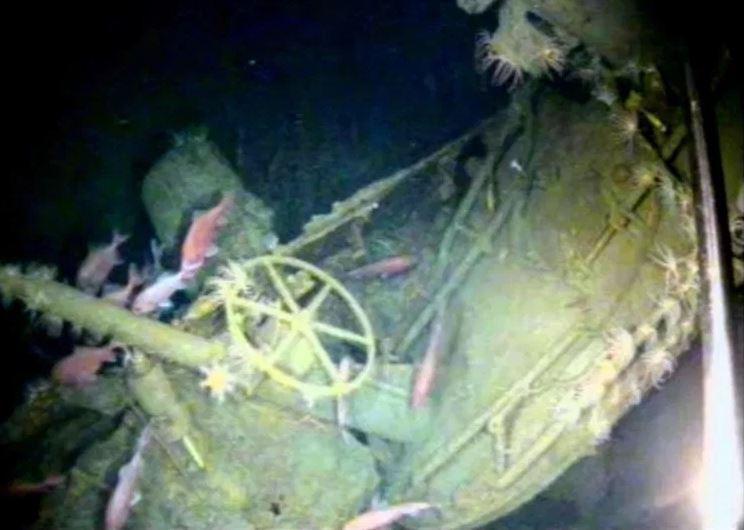
AE1‘s helm. The sudden appearance of fish during the AUV dive signalled that the team were getting close to the submarine. Image: Fugro Survey, via the Royal Australian Navy / © Commonwealth of Australia.
AE1 is found
The noise in the corridor outside my cabin wakes me. It’s several hours since I went to bed and it takes a few moments to remember where I am. I flick on the reading light to find my watch. It’s 9.20 pm and while I am initially annoyed at being woken, my brain is now registering that something is happening and that a loud conversation is going on in the corridor. I open the door to discover the cause of the commotion, momentarily surprising fellow expeditioners Paul Hundley (Silentworld Foundation) and James McPherson (Royal Australian Navy) into silence by my appearance (squinting in the bright corridor light) and my question – ‘What’s happening?’
‘They’ve found something promising on the first AUV run! The Fugro guys are just trying to improve the image in the processing room but they think it’s the submarine.’
Now fully awake, I scramble to find some clothes and make my way down two decks to the data processing room. Under normal conditions it’s a generous space, but is crowded now with expeditioners, technicians and some off-duty crew members. The technicians look tired but, like everyone in the room, they are smiling broadly. A moment later I am looking at the image on the computer monitor that has caused such excitement.
Equipped with side-scan sonar, the AUV (autonomous underwater vehicle) travels at about three knots along a pre-programmed search line, maintaining a safe height above the seabed. As the name suggests, side-scan technology pulses sonic waves laterally from an underwater transmitter that is either towed behind a vessel or, as in this case, ‘flying’ free of the support vessel. As sound waves travelling out from the transmitter strike the seabed, they are reflected back, gradually building a picture of the underwater terrain with all its features.
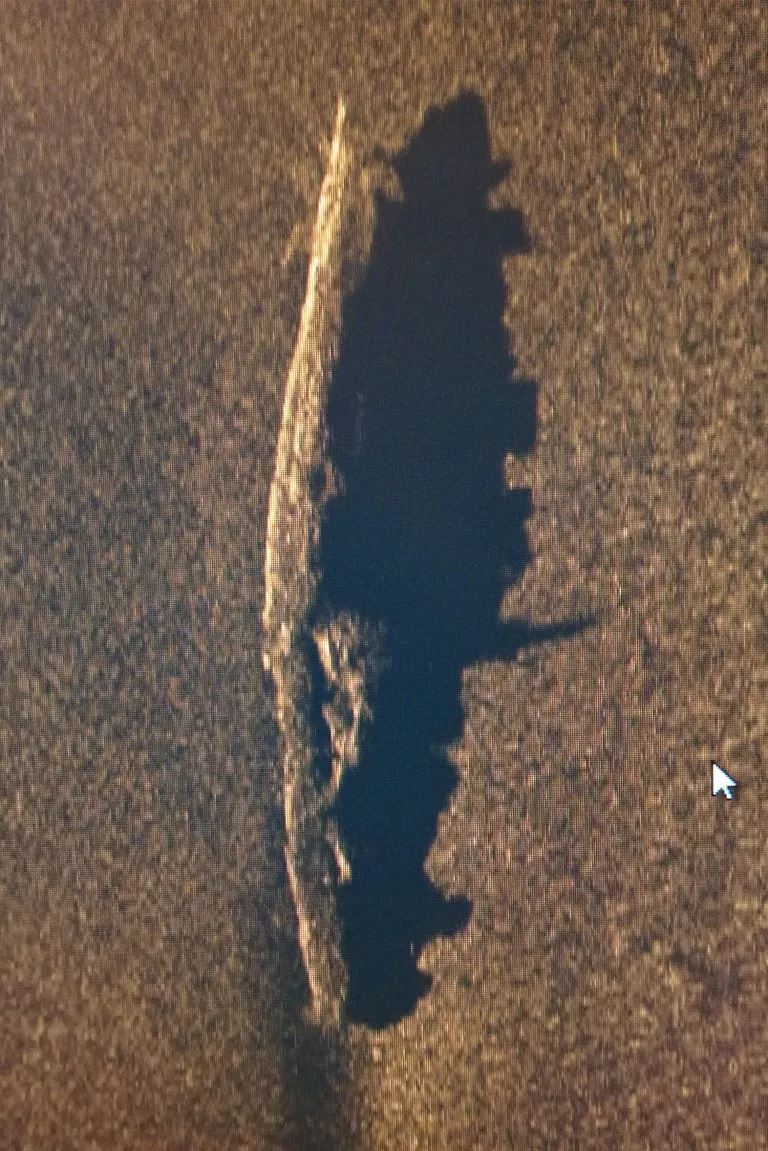
One of the first images of the submarine. A side-scan sonar casts a sonic ‘shadow’ of the wreck. Image: Find the Men of AE1 Ltd.
Imagine a beam of light shining sideways on a rock at night. One side of the rock will be brightly lit, while the other remains in deep shadow. That is what the side-scan image looks like and, depending upon the height of the object off the seabed, it will cast an indicative shadow. Relatively flat objects (or sites) produce small shadows; objects of significant height produce broader shadows. Looking at the processed image from the day’s AUV run there could be little doubt that, more than 100 years after its disappearance in the first stages of World War I, we have found the wreck of Australia’s first submarine, HMAS AE1.

The last known photograph of AE1, taken on 9 September 1914, five days before its disappearance. Image Sea Power Centre Australia.
Background
AE1 and its sister submarine AE2 were built by Vickers at Barrow-in-Furness, England, for the Royal Australian Navy (RAN) and launched in 1913. At the time, E-class submarines represented the latest technological development in submarine design. Fitted with forward, aft and side torpedo tubes, the Australian submarines carried eight torpedos and could run at 15 knots (28 km/h) surfaced using their diesel motors, or nine knots (16.5 km/h) submerged using their electric motors. Although they were larger than earlier classes of submarines, accommodation for the crews on the 54-metre boats was cramped. AE1 carried a crew of 35 when it disappeared without a trace on 14 September 1914.
Leaving England in March 1914 for the long voyage to Australia, the two submarines were escorted by HMS Eclipse as far as Singapore, transiting via Malta, the Suez Canal, Aden and Colombo. HMAS Sydney (I) took over from HMS Eclipse at Singapore for the final leg to Sydney, where they arrived on 24 May 1914. All told, AE1 and AE2 had sailed 13,000 miles (24,000 kilometres) in 60 days. While they were towed by their escort for some of this distance, they operated under their own power for around 9,000 nautical miles (16,600 km). The gruelling voyage broke all records for submarine voyaging and must have sorely tested the crews of Royal Navy (RN) and Royal Australian Navy personnel. At the time of its disappearance AE1’s crew consisted of 24 British sailors, 10 Australians and one New Zealander.
With the addition of the new submarines, the Australian fleet comprised the battle cruiser HMAS Australia, light cruisers Sydney, Melbourne and Encounter, small cruiser Pioneer, and destroyers Parramatta, Yarra and Warrego, as well as older vessels of the former colonial navies.
With the outbreak of World War I in August 1914, and following a refit in dry dock at Sydney’s Cockatoo Island, AE1 and AE2 were sent as part of the Australian Naval and Military Expeditionary Force (ANMEF) to try to neutralise the German presence in New Guinea and to destroy wireless communication stations. Germany had annexed north-eastern New Guinea (Kaiser Wilhelmsland) and the Bismark Archipelago (New Britain and New Ireland) in 1884, and the Marshall Islands and the northern Solomon Islands a year later. The German administrative capital was Rabaul, and German interests in the Pacific were supported by the German Pacific squadron under Admiral Graf von Spee.
In September 1914, AE1 and AE2 were part of the naval force under Rear Admiral Sir George Patey aboard HMAS Australia, supporting the ANMEF landings on 11 September that resulted in destroying German communications, with the formal surrender of Rabaul two days later. The whereabouts of the German Pacific squadron at that time were unknown and, with the possibility that von Spee’s ships could attempt a surprise attack, vessels from the Australian fleet were ordered to patrol St George’s Channel (between New Ireland and New Britain) to control access to Rabaul.
It was while on this duty with its escort vessel HMAS Parramatta that AE1 disappeared, on 14 September 1914. Despite extensive searches during that night and over subsequent days, no trace of the Australian submarine was found – leaving Commander Henry Stoker (in charge of AE2) to conclude that the submarine had probably suffered an accident during diving:
The sinking submarine would slip away down into the vast depths existing in those parts, rapidly filling as the increasing pressure of water outside forced its way through the hull, bringing a quick and clean death to the crew, whose end might well have come before their steel tomb had reached the ocean’s bed – there to rest undisturbed by man and his investigation. Henry Stoker, National Archives of Australia MP 472/1.
With its disappearance, AE1 became the first RAN vessel lost in World War I.

A composite image of the wreck of AE1, comprising of thousands individual photographs, juxtaposed with plan and elevation drawings of the vessel. Image: Find the Men of AE1 Ltd.
The project team
It’s a sobering moment, looking at the grainy side-scan image of AE1 lying deep on the floor beneath our vessel Fugro Equator and remembering that this is the last resting place of 35 men. I can see that other members of the Find AE1 team in the processing room are similarly affected. The core of the team are all ex-submariners who – although serving in much later submarines – share a common camaraderie and experience that link them closely to the men of AE1.
Project leader Peter Briggs (RADM RAN Rtd) served 40 years in the RAN (13 of those in submarines) commanding Oberon class submarines Otway and Oxley, then going on to command the RAN’s submarine squadron before becoming successively Head of Strategic Command, Head of Submarine Capability and Head of Systems Acquisition (Submarines).
Roger Turner (Captain RN Rtd) served 30 years in the Royal Navy. A qualified nuclear power plant operator, he held senior marine engineering posts at sea in a range of classes of submarine and in support positions ashore. Both his father (Lt Cdr Tony Turner) and uncle (Lt Cdr Hugh B Turner DSC) served in the RN – the latter a submarine commander who died during World War II when his vessel, HMS Porpoise, was lost with all hands after a minelaying patrol off the British colony of Penang.
Gus Mellon served in the Royal Australian Navy for 24 years, 18 of them spent in the submarine service. Joining in 1977, he served in Oberon class submarines, reaching the rank of Chief Engine Room Artificer. Commissioned in 1987, he later served as Marine Engineering Officer in HMAS Ovens. His last posting in the RAN was as Staff Officer – Submarine Escape and Rescue, at Navy Office, Canberra, during the lead-up to the sea trials for HMAS Collins.
The combined knowledge of Peter, Roger and Gus on board Fugro Equator provided ‘real time’ initial analysis of the remains of AE1 as we received better imagery of the submarine from the AUV’s next mission and later when the drop camera was sent down, but they are just the ‘tip of the iceberg’ of submariners behind this latest effort to find AE1. Backing up the on-board effort is a much broader group of submariners and other professionals representing the Submarine Institute of Australia (SIA), Silentworld Foundation, Royal Australian Navy, the museum’s Foundation, conservation and heritage experts, as well as, representatives of AE1 descendant groups.
The 2017 search for AE1 is also based on the efforts of previous AE1 searches and the expertise gained from the AE2 project in Turkey, as well as the search for Malaysian Airlines flight MH370 in the deep waters of the Indian Ocean. In the forefront of earlier searches was Commander John Foster RAN. After first becoming interested in the story of AE1 while serving as Assistant Defence Attaché in Port Moresby, Papua New Guinea, in the 1970s. Commander Foster led and actively promoted searches for the submarine over the next 30 years and formed the AE1 Association – the forerunner of Find AE1 Inc. Commander Foster died in 2010, but the success of the 2017 expedition owes an enormous amount to him.
The technology
Unsurprisingly, the success of the 2017 AE1 expedition also owes a great deal to advances in deep-water search technology. Our search vessel, the 66-metre Fugro Equator, is a dedicated survey vessel deploying a Hugin 3000 AUV capable of operating in depths up to 3,000 metres. The ship was one of three survey vessels contracted to search sections of the Indian Ocean for Malaysian Airlines MH370, which disappeared on 8 March 2014 with 239 people on board.
Over a period of 21 months, the ship searched more than 50,000 square kilometres of the seafloor, operating in extreme weather. While not finding any sign of the missing aircraft, that sector of the Indian Ocean search area can now be ruled out in the search for MH370. Thankfully, conditions in the AE1 search area are very different, and are ideal for lowering the drop camera to capture close-up imagery of AE1 in the next phase of the operation.
Unlike conventional ships that use fixed propellers, Fugro Equator is powered by two rudder propellers, providing great manoeuvrability. It also has a bow thruster that controls lateral movement of the forward end of the ship. With these propulsion systems linked to the ship’s dynamic positioning system, the vessel can maintain its position with an incredible accuracy of less than 10 centimetres.

The search expedition’s ship, MV Fugro Equator, is a dedicated survey vessel deploying a Hugin 3000 AUV capable of operating in depths up to 3,000 metres. Image: Find the Men of AE1 Ltd.
The drop camera has a depth rating of 3,000 metres and is fitted with still and video cameras and high-powered LED lamps to enhance visibility. Connected to the ship via a cable, and incorporating twin fins for directional control, the drop camera will transmit the first new images of AE1 in 103 years directly to the processing room. Everyone is excited by the prospect, and the number of people joining the technicians grows steadily as the drop camera is lowered. It’s a long way down and the agonisingly slow descent has everyone on edge as the minutes pass and the live camera feeds a uniform hazy green blur, until the sudden appearance of a fish signals that we are getting close to the submarine.
Moments later there are more fish and then, gradually, a recognisable shape of one of AE1’s hydroplanes comes into shot. It takes a moment to figure out which end of the submarine we are looking at before Peter Briggs begins to direct operations. In communication with the bridge, technicians in the processing room relay Peter’s orders – ‘Half a metre to starboard’; ‘One metre forward’; ‘Lower the camera half a metre’ – and we gradually move along the submarine’s hull, excited by the clarity of the pictures as more-recognisable features come into view.
Up to this point the team had been unwilling to officially confirm the discovery, but any lingering doubts about the vessel’s identity were now completely removed by the stunning pictures of the submarine’s fin, with the bridge helm and forward periscope clearly visible. After several hours the drop camera survey was finally completed and the room erupted in spontaneous applause. With the identity now confirmed, official news of the discovery was passed to the Royal Australian Navy for communication to various descendants of AE1’s crew, followed by an official announcement by the Minister for Defence – setting off a media frenzy.
One last task remained to complete the survey. Once again the AUV was launched, this time programmed to make multiple low-level passes along the submarine to create a complete photomosaic of the site. The results of this last AUV mission provided a stunning overall picture of AE1 and formed the basis for detailed analysis of the damage and its likely causes.

Members of the Find AE1 expedition team with representatives from Fugro Survey. From left: Tanesh Thanapalan (Fugro Survey), Paul Hundley (Silentworld Foundation), Rear Admiral Peter Briggs AO CSC RAN (Rtd) (Find AE1 Ltd), Captain Roger Turner RN Rtd (Find AE1 Ltd), Chandran Karapiah (Fugro Survey), Lieutenant James McPherson RANR (Royal Australian Navy), Gus Mellon (Find AE1 Ltd), Andrej Masloboev (Fugro Survey), Magnus Windle (Fugro Survey), Nigel Erskine (Australian National Maritime Museum), Irini Malliaros (Silentworld Foundation). Image: Bayden Findlay/ Find the Men of AE1 Ltd.
Later that day the AE1 team, Fugro technicians and others who had collaborated so successfully in finding the submarine came together on the ship’s foredeck for a short ceremony to remember the 35 men who died aboard AE1 on 14 September 1914. In light of the images we had all been viewing, the first stanza of the naval ode was especially poignant:
They have no grave but the cruel sea
No flowers lay at their head
A rusting hulk is their tombstone
A fast on the ocean bed.

Studio portrait of Able Seaman Jack Jarman and a young woman, believed to be his sister. Jarman joined the crew of AE1 in February 1914. He was 21 years of age when it disappeared. Image Australian War Memorial P09222.001.
Missing in action: The crew of AE1
Officers
- Lieutenant-Commander Thomas F Besant
- Lieutenant Charles L Moore
- Lieutenant The Hon Leopold F Scarlett
Petty officers and men
- Joseph W Wilson, Chief Engine Room Artificer 2nd class
- Thomas F Lowe, Chief Engine Room Artificer 2nd class
- John A Marsland, Chief Engine Room Artificer 2nd class
- James A Fettes, Engine Room Artificer 3rd class
- John Messenger, Engine Room Artificer 3rd class
- Harry Stretch, Chief Stoker
- Robert Smail, Petty Officer
- Henry Hodge, Petty Officer
- William Tribe, Petty Officer
- Thomas M Guilbert, Petty Officer
- John J Maloney, Stoker Petty Officer
- Charles F Wright, Stoker Petty Officer
- William A Waddilove, Stoker Petty Officer
- Gordon C Corbould, Leading Seaman
- Sidney C Barton, Leading Stoker
- John Meek, Leading Stoker
- William E Guy, Leading Stoker
- John Reardon, Able Seaman
- Frederick W Woodland, Able Seaman
- Jack Jarman, Able Seaman
- James B Thomas, Able Seaman
- Arthur H Fisher, Able Seaman
- Frederick G Dennis, Able Seaman
- George Hodgkin, Able Seaman
- Percy L Wilson, Stoker
- John J Bray, Stoker
- Ernest Blake, Stoker
- Richard B Holt, Stoker
- James Guild, Stoker
- Henry J Gough, Stoker
- George Dance, Signalman
- Cyril L Baker, Telegraphist
— Nigel Erskine, Head of Research.
On June 22 and 23 the museum will hold The Archaeology of War, a two-day conference exploring the importance of archaeology in the investigation of past conflicts, how this has been affected by technological advances and what role archaeology might play in public remembrance.
This article originally appeared in Signals 122 (March 2018). Uncover more maritime history and stories in our quarterly magazine Signals.



